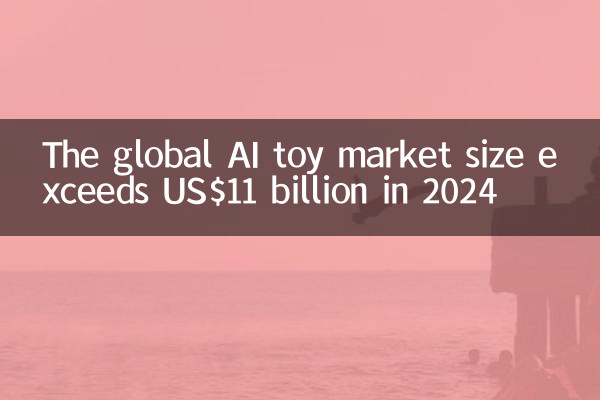The global AI toy market size exceeds US$11 billion in 2024
In recent years, the rapid development of artificial intelligence (AI) technology is profoundly changing all walks of life, and the toy industry is no exception. According to the latest market research data, the global AI toy market size is expected to exceed US$11 billion in 2024, with an annual growth rate of more than 20%. This trend reflects the surge in consumer demand for intelligent and interactive toys, and also indicates that AI toys will become an important tool for children's education and entertainment in the future.
Drivers of AI toy market growth

The rapid growth of the AI toy market is mainly due to the following factors:
1.Technological advancements:The maturity of AI technologies, such as natural language processing (NLP), computer vision and machine learning, enables toys to achieve smarter interactive experiences.
2.Parental needs:Modern parents prefer to buy toys that are both entertaining and educational. AI toys can provide personalized learning content to meet this need.
3.Policy support:Many countries have promoted STEM (science, technology, engineering, mathematics) education, and AI toys have become tools for cultivating children's programming and logical thinking abilities.
4.Consumption upgrade:As families have increased disposable income, parents are more willing to pay a premium for high-tech toys.
Global AI toy market data overview
| years | Market size (USD 100 million) | Annual growth rate | Main application areas |
|---|---|---|---|
| 2022 | 75 | 18% | Education, entertainment |
| 2023 | 90 | 20% | Programming robots, smart voice toys |
| 2024 (Forecast) | 110 | twenty two% | AI companion robots, AR interactive toys |
Popular AI toy types
The most popular types of AI toys on the market today include:
1.Programming robot:Such as LEGO Mindstorms, Makeblock, etc., help children learn basic programming logic.
2.Smart voice toys:For example, Amazon's Echo Dot Children's Edition supports voice interaction and story playback.
3.AI companion robot:For example, Anki's Vector robot has emotional recognition function and can be used as a child's partner.
4.AR interactive toys:Combining augmented reality technologies such as Osmo gaming systems provides an immersive learning experience.
Market Challenges and Future Trends
Despite the broad prospects in the AI toy market, it also faces challenges such as data privacy issues, high R&D costs, and parents' concerns about screen time. In the future, with the further maturity of technology, AI toys will pay more attention to safety and personalization, and will be deeply integrated with the education system, becoming an important assistant to children's growth.
In short, the breakthrough growth of the global AI toy market in 2024 marks the arrival of the era of smart toys. Whether it is a company or a consumer, we need to pay attention to the dynamics in this field to seize future development opportunities.